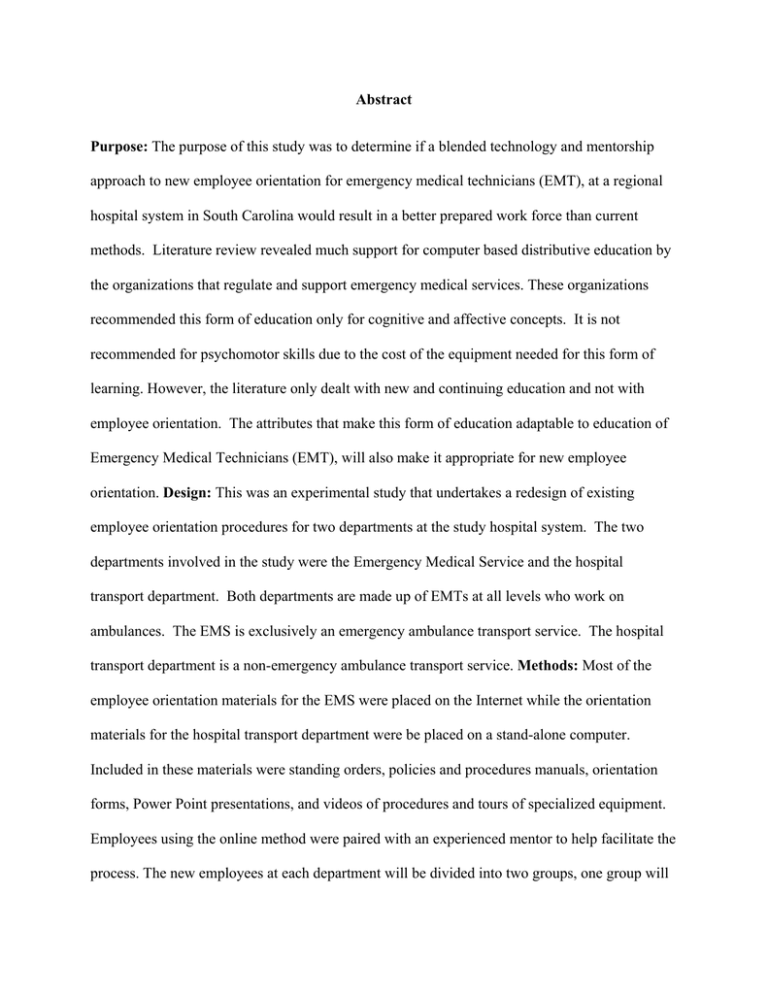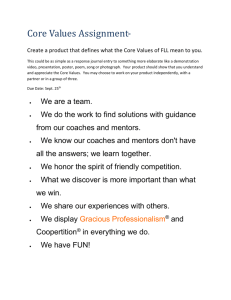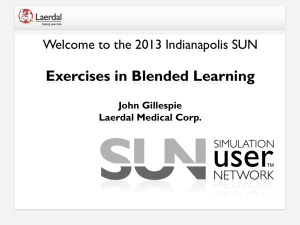Abstract Purpose: approach to new employee orientation for emergency medical technicians (EMT),... hospital system in South Carolina would result in a better...
advertisement

Abstract Purpose: The purpose of this study was to determine if a blended technology and mentorship approach to new employee orientation for emergency medical technicians (EMT), at a regional hospital system in South Carolina would result in a better prepared work force than current methods. Literature review revealed much support for computer based distributive education by the organizations that regulate and support emergency medical services. These organizations recommended this form of education only for cognitive and affective concepts. It is not recommended for psychomotor skills due to the cost of the equipment needed for this form of learning. However, the literature only dealt with new and continuing education and not with employee orientation. The attributes that make this form of education adaptable to education of Emergency Medical Technicians (EMT), will also make it appropriate for new employee orientation. Design: This was an experimental study that undertakes a redesign of existing employee orientation procedures for two departments at the study hospital system. The two departments involved in the study were the Emergency Medical Service and the hospital transport department. Both departments are made up of EMTs at all levels who work on ambulances. The EMS is exclusively an emergency ambulance transport service. The hospital transport department is a non-emergency ambulance transport service. Methods: Most of the employee orientation materials for the EMS were placed on the Internet while the orientation materials for the hospital transport department were be placed on a stand-alone computer. Included in these materials were standing orders, policies and procedures manuals, orientation forms, Power Point presentations, and videos of procedures and tours of specialized equipment. Employees using the online method were paired with an experienced mentor to help facilitate the process. The new employees at each department will be divided into two groups, one group will orient using the current system and the other will orient using the new blended approach. After the orientation process is complete, each group will complete a knowledge test to determine if the blended approach is more effective. The group using the blended technique will also complete a survey in order to assess the accessibility of the technology as well as employee satisfaction with the new approach. In order to get a complete picture of the new approach, the mentors, training staff, and shift coordinators will also be given a survey to determine how effective they feel the new approach is and if it works better for their employees. The results will be analyzed using a t-test for independent means. Results: The results of the study were encouraging. The t-test for independent means showed there was no difference in the test scores of the study group when compared to the comparison group. Survey results indicated that the new employees in the study group liked the new method of orientation and had no difficulties accessing the information or understanding it. Survey results from the mentors and administrators were mixed. Mentors liked both parts of the new method. Administrators liked the mentor portion of the new method but were unsure of the on-line portion of the new method. Overall, responses from all groups were positive. The blended approach of technology and mentorship to new employee orientation at this regional hospital system showed promise. The ttest for independent means showed no significant difference in test scores so the two approaches to orientation are equivalent in knowledge gained. This result was influenced by the small sample size, which may have been too small to detect the true difference in test scores. The real difference was found in the survey results. Conclusions: The mentors and administrators all felt that the new blended approach gave the process a consistency that it had lacked before. They did note that a breakdown of communication occurred between mentors and administrators that must be addressed. The blended approach as a whole resulted in an equivalently prepared new employee that the mentors and administrators felt more comfortable about releasing into the work force to function on their own.




